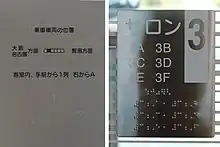Japanese Braille
Japanese Braille is the braille script of the Japanese language. It is based on the original braille script, though the connection is tenuous. In Japanese it is known as tenji (点字), literally "dot characters". It transcribes Japanese more or less as it would be written in the hiragana or katakana syllabaries, without any provision for writing kanji.
| Japanese Braille ⠇⠮⠴⠐⠪⠎⠀⠟⠴⠐⠳ | |
|---|---|
| Type | |
| Languages | Japanese |
Parent systems | Night writing
|
Print basis | Kana |
Child systems | Two-Cell Chinese Braille (in conception) kantenji |

Japanese Braille is a vowel-based abugida. That is, the glyphs are syllabic, but unlike kana they contain separate symbols for consonant and vowel, and the vowel takes primacy. The vowels are written in the upper left corner (points 1, 2, 4) and may be used alone. The consonants are written in the lower right corner (points 3, 5, 6) and cannot occur alone.[1] However, the semivowel y is indicated by point 4, one of the vowel points, and the vowel combination is dropped to the bottom of the block. When this point is written in isolation, it indicates that the following syllable has a medial y, as in mya. Syllables beginning with w are indicated by dropping the vowel points to the bottom of the cell without additional consonant points.[2]
Main chart
The chart below shows each braille character under the corresponding hiragana and its romanization. In order to illustrate the derivation of each character from its component vowel and consonant, the vowel points are written in black, and the consonant points in green. There is no such distinction in braille as it is actually used.[3]
The vowels are assigned the braille patterns that occupy the upper-left half of the cell (dots 1-2-4) in numerical order: ⠁⠃⠉⠋⠊. (These are the first five letters of Braille's alphabet, ⠁⠃⠉⠙⠑, rotated to fit the available space.) The consonantal diacritics, on the other hand, have no apparent connection to international values or numerical order, corresponding as they do to international punctuation and formatting marks.
| ∅ | あ a | い i | う u | え e | お o | |
| ⠁ | ⠃ | ⠉ | ⠋ | ⠊ | ||
| k | か ka | き ki | く ku | け ke | こ ko | |
| ⠡ | ⠣ | ⠩ | ⠫ | ⠪ | ||
| s | さ sa | し shi | す su | せ se | そ so | |
| ⠱ | ⠳ | ⠹ | ⠻ | ⠺ | ||
| t | た ta | ち chi | つ tsu | て te | と to | |
| ⠕ | ⠗ | ⠝ | ⠟ | ⠞ | ||
| n | な na | に ni | ぬ nu | ね ne | の no | |
| ⠅ | ⠇ | ⠍ | ⠏ | ⠎ | ||
| h | は ha | ひ hi | ふ fu | へ he | ほ ho | |
| ⠥ | ⠧ | ⠭ | ⠯ | ⠮ | ||
| m | ま ma | み mi | む mu | め me | も mo | ん n |
| ⠵ | ⠷ | ⠽ | ⠿ | ⠾ | ⠴ | |
| y | や ya | ゆ yu | よ yo | -y- | ||
| ⠌ | ⠬ | ⠜ | ⠈ | |||
| r | ら ra | り ri | る ru | れ re | ろ ro | |
| ⠑ | ⠓ | ⠙ | ⠛ | ⠚ | ||
| w | わ wa | ゐ wi | ゑ we | を wo | -w- | |
| ⠄ | ⠆ | ⠖ | ⠔ | ⠢ |
Other symbols
In kana, a small tsu (っ), called sokuon, is used to indicate that the following consonant is geminate, and in interjections as a glottal stop. In katakana only, a long vowel is indicated with a horizontal stroke (ー) called a chōon. This also looks like a half dash in braille:[3]
| sokuon | chōon |
| ⠂ | ⠒ |
The placement of these blocks mirrors the equivalent kana: the sokuon indicates that the following consonant is geminate, whereas the chōon indicates that the preceding vowel is long.
In kana, the voiced consonants g, z, d, b are derived from the voiceless consonants k, s, t, h by adding a diacritic called dakuten to the kana, as in ぎ gi; in foreign words, vu is written by adding this to the vowel u. Similarly, p is derived from h by adding a small circle, handakuten. Two kana are fused into a single syllable by writing the second small, as in きゃ kya from ki + ya; this is called yōon.[3]
In Japanese Braille, the signs for these are prefixes. That is, the order is dakuten + ki for ぎ gi. When more than one occurs in a single syllable, they are combined in a single prefix block, as the yōon-dakuten used for ぎゃ gya.[3]
| dakuten (g-) |
handakuten (p-) |
yōon (-y-) |
yōon + dakuten |
yōon + handakuten |
| ⠐ | ⠠ | ⠈ | ⠘ | ⠨ |
The yōon prefix uses the point that represents y in the blocks ya, yu, yo. When placed before ka, ku, ko, it produces kya, kyu, kyo. Likewise, the yōon-dakuten prefix before ka, ku, ko creates gya, gyu, gyo. And so on for the other consonants.
Unlike kana, which uses a subscript e, in braille the -ye in foreign borrowings is written with yōon and the kana from the e row: that is, kye, she, che, nye, hye, mye, rye, voiced gye, je, bye, and plosive pye are written with the yōon prefixes plus ke, se, te, ne, he, me, re. The syllable ye is written yōon plus e.
There is also a prefix for medial -w- called gōyōon. When combined with ka, it produces the obsolete syllable kwa. It may also be fused with the voicing prefix for gwa. For foreign borrowings, this extends to kwi, kwe, kwo and gwa, gwi, gwe, gwo. Gōyōon may also be combined with the vowels i, e, o for foreign wi, we, wo (now that the w in the original Japanese kana for wi, we, wo is silent); with ha, hi, he, ho for fa, fi, fe, fo and (when voiced) for va, vi, ve, vo; and with ta, chi, te, to for tsa, tsi, tse, tso. These two prefixes are identical to the question mark and full stop.
| gōyōon (-w-) |
gōyōon + dakuten |
| ⠢ | ⠲ |
These all parallel usage in kana. However, there are additional conventions which are unique to braille. Yōon and yōon-dakuten are also added to chi and shi to write ti, di and si, zi found in foreign borrowings; similarly gōyōon and gōyōon-dakuten are added to tsu to write tu, du. This differs from the system used in kana, where the base syllables are te and to respectively, and a subscript vowel i or u is added.
In an assignment that is counter-intuitive in kana, yōon + handakuten is prefixed to tsu, yu, yo to produce tyu, fyu, fyo in foreign words, and voiced for dyu, vyu, vyo. The latter—yōon + dakuten + handakuten, is impossible in kana:
| yōon + dakuten + handakuten |
| ⠸ |
Orthography
Japanese Braille is written as print Japanese would be written in kana. However, there are three discrepancies:
- In print, the ubiquitous grammatical particles wa and e have the historical spellings は ha and へ he. In braille, they are written as they are pronounced, ⠄ wa and ⠋ e.[4]
- The long ō sound is written with ⠒ (chōon), as it would be romanized, regardless of whether it is oo or ou in print Japanese. Long ū is also written with a chōon rather than a u. (This is a common convention in katakana, but does not occur in hiragana.) Thus Tōkyō, sorted as Toukyou in dictionaries, is nonetheless written ⠞⠒⠈⠪⠒, and sansū is written ⠱⠴⠹⠒.
- Spaces are used to separate words (though not clauses or sentences, where punctuation performs that function). Thus 今日は朝からよく晴れている。 is spaced as in its romanization, though without separating particles from their nouns: Kyōwa asakara yoku harete iru. ⠈⠪⠒⠄⠀⠁⠱⠡⠑⠀⠜⠩⠀⠥⠛⠟⠀⠃⠙⠲ Spaces are also placed between family and personal names, as in 石川倉次 Ishikawa Kuraji. When writing in katakana, an interpunct ⟨・⟩ is used for this function in print, as in ルイ・ブライユ Rui Buraiyu (Louis Braille).
Punctuation
Besides the punctuation of Japanese, braille also has symbols to indicate that the following characters are digits or the Latin alphabet.[3]
| 。 | 、 | ? | ! | 「・・・」 | (・・・) | hyphen | — | ・・・ | space |
| ⠲ | ⠰ | ⠢ | ⠖ | ⠤⠀⠤ | ⠶⠀⠶ | ⠤ | ⠒⠒ | ⠂⠂⠂ | ⠀ |
As noted above, the space is used between words and also where an interpunct would be used when names are written in katakana. There are several additional punctuation marks.
Formatting

Western letters and digits are indicated as follows:
| Digit(s) | Latin letter(s) |
capital letter |
| ⠼ | ⠰ | ⠠ |
An additional sign indicates that the following characters are specifically English words and not just in the Latin alphabet.
Words immediately follow numbers, unless they begin with a vowel or with r-. Because the syllables a i u e o and ra ri ru re ro are homographic with the digits 0–9, a hyphen is inserted to separate them. Thus 6人 "six people" (6 nin) is written without a hyphen, ⠼⠋⠇⠴ ⟨6nin⟩, but 6円 "six yen" (6 en) is written with a hyphen, ⠼⠋⠤⠋⠴ ⟨6-en⟩, because ⠼⠋⠋⠴ would be read as ⟨66n⟩.
Notes and references
- An isolated t would be read as wo, for example. The only exception to restriction is m, which when written alone is the syllabic nasal. This may be a design feature, as historically the syllabic nasal derives from mu.
- Except for the syllable wa, historic w is silent in modern Japanese.
- "点字を読んでみよう (tenji o yonde miyō)". Braille Authority of Japan. Retrieved 2012-05-10.
- This does not mean Japanese Braille is completely phonetic. The grammatical particle を wo, which is pronounced o, is nonetheless written ⠔ wo.
External links
| Wikimedia Commons has media related to Japanese braille. |
- The Braille Authority of Japan – the standard-setting body for braille notation in Japan
- World Blind Union
- "The Monument "Birthplace of Tokyo Moa Gakko and Japan Braille System" unveiled"